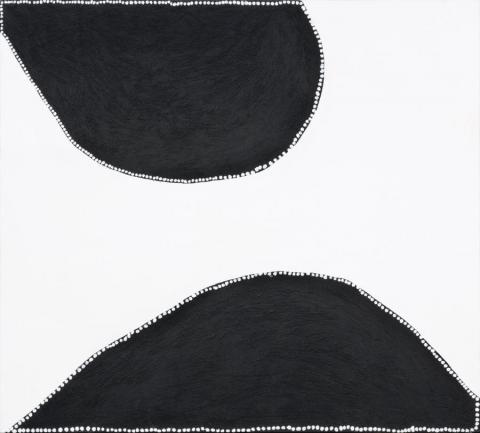THOOWOONGGOONARRIN, 2000
PADDY NYUNKUNY BEDFORD
natural earth pigments and synthetic binder on linen
122.0 x 135.0 cm
signed with initials verso: PB
inscribed verso: Jirrawun Arts cat. PB 8 2000.91
Jirrawun Aboriginal Arts, Kununurra
Martin Browne Fine Art, Sydney
Private collection, Melbourne
My Mother's Country, My Father's Country: New Paintings by Paddy Bedford, Martin Browne Fine Art, Sydney, 12 September – 8 October 2000
Paddy Bedford, Museum of Contemporary Art, Sydney, 6 December 2006 – 15 April 2007
Storer, R., Paddy Bedford, Museum of Contemporary Art, Sydney, 2006, pp. 43, 149 (illus.)
Sir William Dean in his eulogy to Paddy Bedford, in September 2007, recalled that Bedford was a man of 'great dignity and spiritual strength' a much loved senior Elder and lawman who late in the story of his life discovered a rare artistic genius that resulted in him being recognised as one of the great painters of our continent.'1
According to Tony Oliver (who was to prove instrumental in Bedford's career and the development of Jirrawun Aboriginal Art Corporation) Bedford was close friends with Paddy Jaminji, Hector Jandany and Rover Thomas whose canvases he helped to prepare and whose progress he quietly observed. But it was only after these pioneers of the Kimberley movement died that Bedford took on the responsibility of painting ceremonial boards. In1997 he started painting his stories on board and canvas with a remarkable authority and confidence, consistent with his importance as a traditional elder of high regard. Within several years Bedford acquired a reputation for not only inheriting the legacy of Rover Thomas but of pushing new boundaries with his famously fluent 'walking line'. Steeped in traditional law and the Ngarranggarrni (Gija dreaming) he drew on a seemingly endless source of traditional lore and knowledge of significant sites. His paintings combine important family Dreamings such as Garnanganyjen (Emu), Birnkirrbal (Bush Turkey) and Ngayilanji (White Cockatoo) with the physical world of roads, rivers, traditional life, stock camp life, stock yards and country visited while mustering. His work has been hailed as that of a 'new' Rover Thomas even though he was born a few years before him.
The importance of painting for Paddy Bedford was multi-layered; an expression of country and cultural memory as well as being a claim to identity and consequently an assertion of claim to the land itself. As Michael Dolk argues, painting suggests a physical and tactile relation to land 'To behold painting is to hold country and to remain beholden to its ancestral tradition.'2
Catalogued as painting PB 8 2000.91 in Bedford's chronological index of works, this painting on linen was executed in 2000, and represents the country of Tunganary, Thoowoonggoonarrin, to the south of Bedford Downs in his mother's country. Tunganary Gorge is home to a permanent waterhole and is the dreaming place for Thoowoonggoony,a large tree with dark leaves that is related to the fig tree (Celtis philippinensis). The artist's mother's sister died and is buried in this country.
Thoowoonggoonarrin characterises Bedford's move away from the more familiar style of the earlier east Kimberley painters to create his own representations of country. His use of colour has evolved and the elimination of the ochre palette and introduction of a starkly contrasting black and white where form becomes dominant highlighting the interplay between positive and negative space.
1. Dean, Sir William, 'Eulogy for Old Man,' in Paddy Bedford; Bury My Heart at Bow River, exhibition catalogue, William Mora Galleries, Melbourne, 2009, p. 14
2. Dolk, M., 'Are we Strangers in this Place', in Storer, R., Paddy Bedford, Museum of Contemporary Art, Sydney, 2006, p. 20
